Wondering about investing in a new wetsuit but doesn’t know which one suits you?
Basically, maybe you don’t know the difference between a freediving wetsuit and a scuba diving wetsuit.
So, what do you think is the difference between a freediving wetsuit and a scuba diving wetsuit?
Read on, and you’ll find out all about freediving and scuba diving wetsuits.
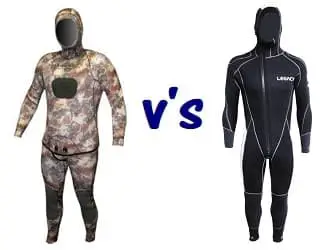
Freediving Wetsuit vs Scuba Wetsuit: Differences
The primary difference between a freediving wetsuit versus a scuba wetsuit is how huge the nitrogen bubbles are in each wetsuit.
Freediving wetsuits have huge nitrogen rises, with slight neoprene elastic ‘dividers’ bringing about a lot of slenderer, yet hotter wetsuit.
Scuba diving wetsuits have little nitrogen rises, with thick neoprene elastic linings bringing about a lot thicker, cooler wetsuit.
Wetsuit Neoprene is an elastic froth used to make, well, a wetsuit. Close cell neoprene is called the air pockets and is caught in the neoprene elastic froth and between at least one layer of texture. Close cell implies that every nitrogen bubble is encompassed and isolated by neoprene. Both freediving and scuba suits are made of close cell neoprene.
Freediving Wetsuit
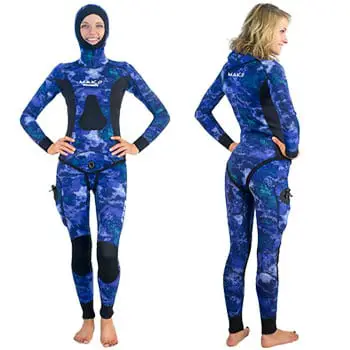
The freediving neoprene, or some of the time called open-cell, is a low or medium thickness neoprene. Meaning the air bubbles are bigger, and the dividers between the air bubbles are slender than those in a scuba wetsuit.
The outcome is the suit extends more, is milder, and entirely comfortable. However, the bigger air bubbles pack effectively with profundity. There is no inward coating in a freediving wetsuit, so the thinner neoprene sticks to the body with no water layer between the suit and skin. The suit is used for protection that brings a hotter suit superficially defenceless against tearing and hard to get into. Freedivers, for the most part, use grease, for example, foamy water, to get into their wetsuits.
Check Cressi APNEA, Man Freediving Spearfishing Premium Neoprene Wetsuit here.
Scuba Wetsuit
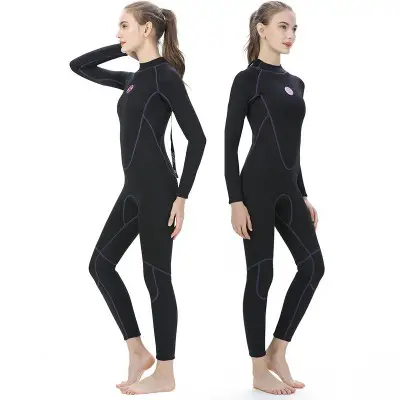
The scuba neoprene is ordinarily a high thickness neoprene that is lined on the two sides. The air pockets are littler, and the dividers around the air pockets are thicker. These suits are less stretchy, yet they don’t pack as much with profundity. Thusly the scuba suit gives better protection at depth. The inward covering makes the suit simple to dive on and off. This inside coating permits a flimsy layer of water to shape between the skin and the suit. That warm water layer gives the diver protection. Since the scuba suit is commonly thicker, denser, and inside lined. It will be commonly more powerful than the freediving suit.
In outline at that point, the two suites can be utilized for either freediving, where most of the time is spent superficially or scuba, where most time is spent at depth. All things considered, each suit is planned in light of a particular reason;
- The low or medium thickness for freedivers.
- The high thickness for scuba divers.
Check scuba diving wetsuit here.
Freediving Wetsuit vs Scuba Wetsuit: Overview
As we probably know, water conducts heat away from the body significantly quicker than air 20x quicker, so ensuring that we are wearing a proper presentation suit is urgent to guarantee that we remain warm.
What a wetsuit is used for?
Wetsuits keep us warm by having heat protecting air pockets of nitrogen gas caught in the neoprene of the suit. These are warmed alongside a meagre water layer by our body warmth and keep us toasty while diving. We regularly get asked the distinction between our freediving suits and our scuba diving suits and what is better. In all actuality, they are altogether different and are clearly made to fill somewhat various needs.
The Differences:
The greatest distinction comes down to the thickness and, in this manner, the size of the air bubbles in the neoprene. If that suit is made with enormous air bubbles and more slender dividers encompassing each air bubbles, that suit is alluded to as low thickness. This material will be delicate, exceptionally stretchy, and have solid protecting properties, making for a truly comfortable suit.
The inconvenience of low thickness neoprene is that when taken to depth, is packs no problem at all. As it gets slenderer, its capacity to hold heat decreases. While freediving, spearfishing, and swimming, most of the time is spent superficially. The low thickness neoprene is perfect, being comfortable and warm.
Most scuba diving suits are produced using high thickness neoprene;
- Thicker walls.
- Smaller bubbles.
This allows the suit to keep up its protecting properties while at depth.
The covering on the suits is another distinctive component. Most scuba suits are lined on both within and out. This fortifies the suit considerably. However, it decreases the measure of flex and stretch.
Most freediving suits have a light covering outwardly for insurance. However, leave within unlined. This considers a superior fit to the body and amplifies the scope of development.
Bottom line:
- The suits are in the same class as one another in their component.
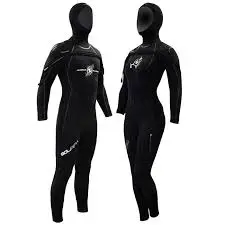
Freediving Wetsuit vs Scuba Wetsuit: Effects on Diving
Buoyancy:
Since freediving wetsuits are so slight, they are additionally less light than scuba suits.
This is useful for freedivers as the less light your wetsuit seems to be, the fewer loads you have to wear to slide and drag back up again during your ascending.
Scuba wetsuits then again are thicker, so they are more buoyant. This is the principle reason free divers keep away from scuba suits. You don’t need that additional drag as a freediver, easing back you down while you dive.
Flexibility
An awesome component of freediving wetsuits is that since they are so flimsy, they are amazingly adaptable.
Freediving with great adaptability or flexibility is important. The more adaptable, flexible and light-footed you are underwater, the more agreeable you’ll be prompting longer breath-holds.
An adaptable and flexible wetsuit also helps boost your breath-hold, as it lets you breathe in more oxygen.
If you used a resolute scuba wetsuit, the suit would contract your chest, bringing down your absolute lung limit and volume. This can diminish the measure of air you breathe in by up to 1 litre to 0.25 gallons.
Side note:
Is your weight belt made of nylon? Assuming this is the case, that also is presumably destroying your pre-dive breathing up. Nylon is a rigid material, and in this way, contracts your stomach as you breathe in.
I suggest putting resources into an elastic weight belt like this one here, as it will really extend as you breathe in, prompting more oxygen and longer diving times.
In general:
Freediving with a scuba suit will, in general, lead to shorter breath-holds with shallower plunges. As well as being slower in the water.
Durability:
Freediving wetsuits are dainty, so they are considerably less sturdy than scuba wetsuits.
In case you’re a speared, fare thee well in case you’re between rocks, so you don’t granulate against them and tear your suit.
Freediving Wetsuit VS Scuba Wetsuit
Free dive suits have two key highlights that make them not the same as scuba suits:
- Adaptability or Flexibility
- Warm properties or Thermal properties.
Proficient free dive suits are more adaptable than ordinary scuba suits. Having a stretchy suit nearly wants to wear nothing, so you can focus on your dive instead of battling with an unbending texture caused distress.
Taking a gander at the warm properties angle, it is acceptable to understand that; free divers will need to invest longer energy in the water than scuba divers.
A decent freediving wetsuit keeps you warm during longer meetings as well. Feeling good temperature-wise is essential: if you feel cold and begin shuddering, you can’t control your pulse, and it will influence your breathing as well.
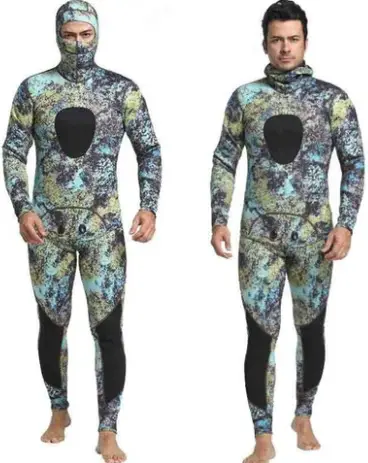
Closed Cell Vs Open Cell:
A closed-cell wetsuit is essentially a wetsuit that has a polyester or other material lining within. This makes it simpler to put on. However, it keeps you less warm.
Practically all scuba diving wetsuits are close cell wetsuits.
An open-cell wetsuit is a thing that free divers love and use routinely. Open-cell essentially implies that there is no inside covering within your wetsuit.
At the end of the day: it’s simply unadulterated elastic against your skin. This not just aides the wetsuit fit firmly and pleasantly against your skin to diminish drag.
Yet additionally keeps you pleasant and warm, much the same as a decent pair of neoprene gloves and socks.
Close Cell Suit
Close cell suits are the customary wetsuits that are normally utilized for scuba plunging. Yet, one can discover shut cell freediving wetsuits too—closed-cell neoprene wetsuits made of neoprene with lycra layers of nylon on the two sides.
Pros:
- The outside coating makes the wetsuit solid and sturdy. This is significant for scuba divers who put a ton of rigging on that can harm the suit. This factor isn’t generally significant for freedivers who typically utilize just an elastic weight belt as hardware.
- To get into the suit, you don’t have to lube it. It very well may be dry or wet while putting on, doesn’t generally make a difference, you can spruce up like regularly.
- Lower cost.
Cons
- Water will flush through the suit while plunging. In this manner, it won’t keep you warm over the long haul.
- The outside nylon or lycra layer confines the stretch and makes developments restricted.
Open Cell Wetsuit
Freediving wetsuits regularly use open-cell suits due to incredible flexibility and better protection. There is no nylon or lycra layer on the suit’s internal side, so the neoprene elastic reaches your skin. The suit frames a seal with your skin not letting water flush through it, causing you to feel altogether hotter.
Pros:
- Flexibility, you can move uninhibitedly.
- Great warm properties keep you warm more while diving and practising.
- Most generally utilized 2-piece free dive suits can be requested with various estimated top and base parts – simpler to coordinate with your body type.
Cons
- You have to lube it when putting it on.
- The inward side is delicate, and you can tear or cut it coincidentally with sharp items or even with nails. To fix the shopping centre cuts, you need a neoprene stick.
- Less solid than standard suits.
- More expensive.
One Piece vs Two Piece Wetsuits
Freediving wetsuits ordinarily come as two-piece wet suits. You have the super first 50% of the wet suit. At that point, besides, you have the bottoms, which seem as though cultivating overalls.
The purpose behind this is because freediving wet suits normally come as open-cell wetsuits, making them difficult to get into because they are so tight.
Consequently, a two-piece wet suit makes it simpler to get into and gives more warmth and adaptability and fits a whole lot superior to a one-piece.
Scuba wetsuits commonly come as one-piece wetsuits, which bring about them not being as custom-made to your body as producers can’t do as an exact cut.
Zippers
Freediving wetsuits have no zippers since zippers spill, include additional drag while finning and diminished flexibility.
So, in case you’re a freediver, make a point to avoid zippers. In any case, since you have no zippers on your freediving wetsuit, getting into it tends to be a gigantic errand.
You’ll have to use either lube or conditioner to slide into the suit, no problem at all. Likewise, some divers are known using;
- Baby powder
- Soap, corn starch or;
- Even a low-pH cleanser.
Not at all like freediving wetsuits, scuba wetsuits accompany zippers, making them a lot simpler to get into.
Hoods
Not at all like scuba wetsuits, freediving wetsuits accompany hoods introduced in the rear of them. A staggering measure of warmth is lost from your head.
So, a wetsuit hood truly assists with keeping warm in cool atmospheres. Particularly with keeping your ears decent and warm.
In some cases, freediving wetsuits don’t accompany hoods. You may likewise need to place a smidgen of water in it before diving when wearing a hood. This will assist you with adjusting while at the same time wearing it by halting the air in the hood, compacting and adhering to your ears during your dive.
Wetsuit Thickness for Water Temperature
| The Thickness of Wetsuit (mm) | Water Temperature in Celsius (C°) |
| 7 mm | 10°C- 18°C |
| 6-7 mm | 13°C- 21°C |
| 4-5 mm | 15°C- 24°C |
| 3 mm | 18°C- 27°C |
| 1-2 mm | 21°C- 30°C |
Conclusion:
If you are a water person doing some watersports, choosing the right wetsuits in your sports is very important.
Whether you will choose from freediving and scuba diving wetsuits for your perfect suit, the important is you know it’s differences.
Hopefully, this article helps you find the perfect suit for your watersports.
Please also read the difference between wet and dry suit here.
